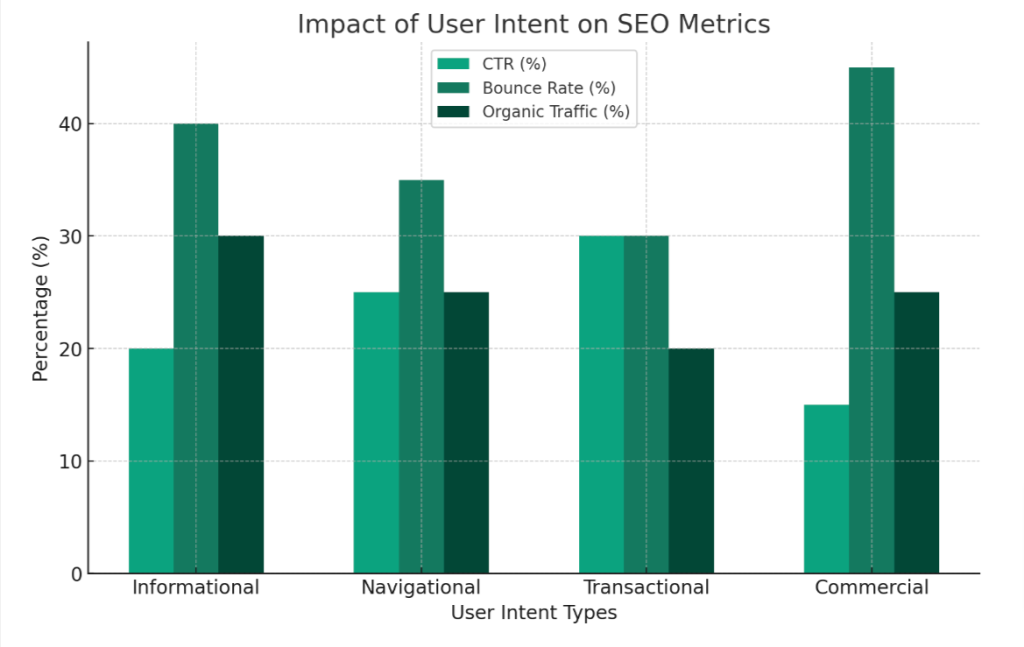Aligning Your Content with User Intent for Better SEO
Are you struggling to capture your target audience’s attention despite using specific keywords in your content? The fact is, 93% of online experiences begin with a search engine, but it’s not just about the words people type.
This blog post will guide you through understanding and incorporating user intent into your writing process – revolutionizing your content creation strategy. Read on to discover how satisfying user intent can skyrocket your site’s organic traffic!
Key Takeaways
- User intent refers to the underlying motivation and purpose behind a user’s search query, and understanding it is crucial for creating effective and targeted content.
- By analyzing search queries, using keyword research tools, conducting audience research, studying competitor content, and analyzing user behavior metrics, you can discover user intent and create content that meets the needs of your target audience effectively.
- User intent plays a crucial role in SEO as it determines how well your content aligns with what users are searching for. By optimizing your content for user intent, you can improve organic traffic and enhance your marketing strategy.
What is User Intent?
User intent refers to the underlying motivation and purpose behind a user’s search query. By understanding what users are actually looking for, businesses can create content that aligns with their needs and provides value.
Definition
User intent refers to the goal a user has in mind when typing a query into a search engine. Often categorized as informational, navigational, transactional, or commercial, understanding user intent helps content creators optimize their work for better visibility online.
It’s not just about the keywords users enter; it’s also about why they’ve entered them and what kind of results they expect to find. This concept underscores the importance of knowing your audience and tailoring your content accordingly for effective search engine optimization strategies.
Identifying User Intent
Mastering user intent begins with a keen understanding of your audience. Start by digging deeper into collective actions and behavior patterns to offer insights into their needs. Here’s how:
- Analyze Search Queries: Look at the phrases people use when they perform an internet search. Collect common terms, frequently asked questions, or specific product queries to better understand user intent.
- Group Keywords Into Categories: Organize all collected keywords and target phrases into broad categories. This could include transactional intent, navigational intent, commercial intent, or informational intent.
- Learn from User Behavior on Site: Use analytics to see what content attracts the most visitors. Also, review which pages have high bounce rates to identify potential mismatches between offered content and searcher’s intent.
- Study Competitor Sites: Review content on sites that rank highly for your target keywords. Understand what they are providing that matches the user’s needs and adapt your strategy accordingly.
- Conduct Surveys or Interviews: Directly ask your audience about their needs and wants. Their responses can provide invaluable insight into user intent optimization.
- Utilize SEO Tools: Using SEO tools like Google Trends, Keyword Planner etc., can help you better understand seasonal trends, geographical differences, and other valuable factors in determining user intents.
Understanding User Intent
User intent refers to the reason behind a user’s search query, and understanding it is crucial for creating effective and targeted content.
Types of User Intent
User intent can be categorized into multiple types based on the goal of the internet user when they type into the search bar. Here’s a brief overview of the different types of user intent.
| User Intent Type | Description |
|---|---|
| Informational Intent | This is when a user is seeking information on a specific topic. They might be looking for answers to their questions, or detailed information about something. |
| Navigational Intent | In this case, the user knows the website they want to visit and they’re using the search engine to find it. |
| Transactional Intent | This type of search comes with the intention to complete a transaction. It could be purchasing a product, booking an appointment, or signing up for a service. |
| Commercial Intent | This is when a user is in the research phase prior to purchase. Their searches are often targeted at comparing products, reading reviews or simply studying alternatives before making a decision. |
Understanding these types can help tailor your website content to meet the users’ needs effectively and efficiently.
How People Search
People search for information on the internet in various ways. Understanding how people search is crucial in creating user-intent optimized content that resonates with your audience.
When searching online, users typically use search queries or target phrases to find what they’re looking for. By analyzing user behavior and examining keyword matching, SEO professionals can gain insights into user intent optimization.
This helps drive organic traffic and improve the overall effectiveness of their marketing strategy. User-centric writing and intent-driven content play a vital role in enhancing user engagement, satisfaction, and ultimately guiding users through their journey on the website.
Discovering User Intent
To create user-intent optimized content, it’s important to understand how to discover user intent. Here are some key steps to help you:
- Analyze search queries: Pay close attention to the specific keywords and phrases that users are searching for. This will give you valuable insights into their intentions.
- Use keyword research tools: Utilize tools like Google Keyword Planner or SEMrush to identify popular search terms related to your topic. This will help you uncover the types of information users are seeking.
- Conduct audience research: Understanding your target audience is crucial for discovering their intent. Conduct surveys, interviews, or gather data from social media platforms to gain insights into their needs and preferences.
- Analyze competitor content: Look at what your competitors are doing and how they are addressing user intent in their content. This can provide inspiration and help you identify gaps that you can fill with your own content.
- Study user behavior metrics: Dive into analytics data such as bounce rate, time on page, and click-through rates to gain a deeper understanding of how users interact with your website. This can reveal patterns and clues about user intent.
- Implement user journey mapping: Mapping out the different stages of a user’s journey on your website can give you a clearer picture of their intent at each stage. This will allow you to tailor your content accordingly.
The Importance of User Intent
User intent plays a crucial role in SEO as it determines how well your content aligns with what users are searching for, which ultimately affects your organic traffic and search engine rankings.
How it affects SEO
User intent plays a crucial role in search engine optimization (SEO). By understanding and catering to user intent, you can improve your website’s visibility and ranking on search engine results pages.
When your content aligns with what users are looking for, it increases the likelihood of attracting organic traffic to your site. This is because search engines prioritize content that satisfies user intent, leading to higher rankings.
So, by optimizing your content for user intent, you can enhance your marketing strategy and reach a wider audience effectively.

How to apply it to your content strategy
To apply user intent to your content strategy, follow these steps:
- Define your target audience: Understand who your audience is and what they are looking for when they search online.
- Conduct keyword research: Identify the keywords and phrases that align with the user intent you want to target.
- Optimize your content: Create high-quality, informative content that satisfies the specific needs of your target audience.
- Use relevant headings and subheadings: Structure your content in a way that guides users through their journey and helps them find the information they need quickly.
- Incorporate long-tail keywords: Include longer, more specific keywords in your content to attract users who have clear intent and are closer to making a decision.
- Monitor performance and make adjustments: Regularly analyze how well your content is performing in terms of user engagement and organic traffic. Make necessary changes based on the data you collect.
- Stay up to date with trends and changes: Continuously adapt your content strategy to match evolving user behaviors, search trends, and algorithm updates.
How to Create User-Intent Optimized Content
To create user-intent optimized content, start by understanding keyword research and organizing your site structure effectively. Then, focus on nailing down user intent by analyzing user behavior and mapping their journey.
By creating content that matches the intent of your target audience, you can improve organic traffic and enhance user engagement and satisfaction.
Understanding keyword research
Keyword research is a critical component when it comes to creating user-intent optimized content. It involves understanding the search queries and target phrases that your audience uses when looking for information online.
By conducting keyword research, you gain insights into what keywords are relevant and popular within your industry. This knowledge allows you to create content that aligns with user intent, ensuring that your website appears in organic search results and drives more traffic to your site.
With an understanding of keyword research, you can effectively optimize your content strategy and improve your chances of reaching your target audience.
Organizing your site structure
To optimize your content for user intent, it’s important to organize your site structure in a way that aligns with the needs and expectations of your audience. Here are some key steps to consider:
- Categorize your content: Divide your website into logical categories or sections that reflect the main topics or themes you cover. This helps users navigate through your site more easily and find the information they’re looking for.
- Create a clear hierarchy: Arrange your content in a hierarchical structure, with broad categories at the top and more specific subcategories underneath. This allows users to drill down into the relevant sections without getting overwhelmed by too much information.
- Use intuitive navigation menus: Make sure your navigation menus are easy to understand and navigate. Use descriptive labels for each menu item and organize them in a logical order that makes sense to users.
- Link related content: Within each category or subcategory, link related pieces of content together. This helps users discover additional information on a particular topic and encourages them to explore more of your website.
- Optimize for mobile devices: With more people accessing websites from their smartphones or tablets, it’s crucial to ensure that your site structure is mobile-friendly. Use responsive design techniques to adapt your layout and navigation for different screen sizes.
- Utilize breadcrumbs: Breadcrumbs show users the path they have taken on your website, making it easier for them to navigate back to previous pages or categories if needed.
Tips for nailing down user intent
Here are some tips to help you better understand and meet user intent:
- Analyze search queries: Study the specific words and phrases that users enter into search engines to gain insights into their intentions.
- Use keyword research tools: Utilize tools like Google Keyword Planner or SEMrush to discover popular keywords related to your content and target audience.
- Look at search results: Examine the top-ranking pages for your target keywords to see what kind of content is already meeting user intent effectively.
- Consider user demographics and behavior: Understand your target audience’s demographics, preferences, and habits to tailor your content towards their specific needs.
- Conduct competitor analysis: Investigate how competitors are addressing user intent in their content to identify potential gaps or areas for improvement.
- Create relevant, valuable content: Craft informative, engaging content that directly answers users’ questions or solves their problems, aligning with their intentions.
- Optimize metadata and headlines: Ensure that your page titles, meta descriptions, and headlines accurately reflect the content’s purpose and appeal to users’ expectations.
- Test different approaches: Experiment with different angles, formats, or types of content to see which ones resonate best with your target audience’s intent.
Conclusion
In conclusion, understanding and optimizing for user intent goes beyond simply targeting keywords. By analyzing user behavior, search queries, and their intent behind them, you can create content that provides valuable information and meets the needs of your audience.
With a user-centric approach to writing and optimization, you can improve user engagement, satisfaction, and ultimately drive organic traffic to your website. So remember, when it comes to writing for user intent, don’t just focus on keywords – dive deeper into what your users really want.

